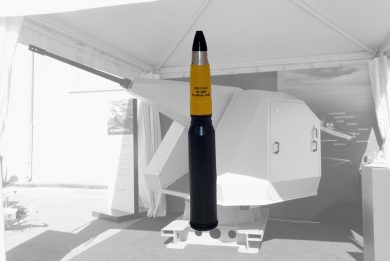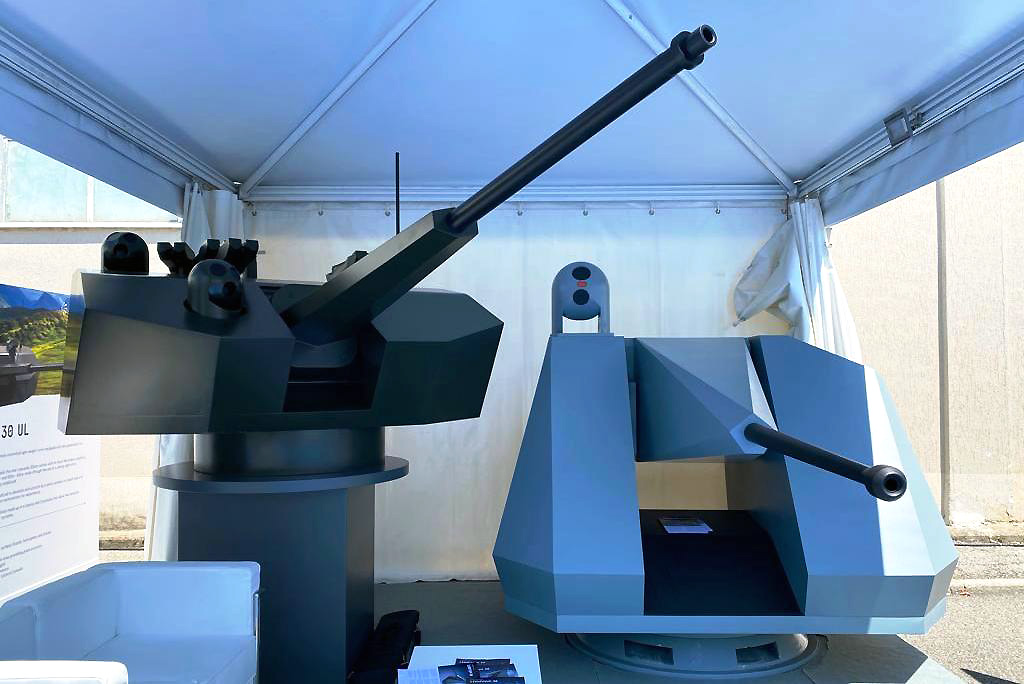
SeaFuture 2023 – Leonardo unveils new 30×173 mm X-Gun weapon system
Leonardo unveiled at SeaFuture its new X-Gun, chambered in 30×173 mm, a related ammunition developed by Simmel Difesa, part of Nexter Arrowtech, and two turrets, one aimed at armoured vehicles and the other at naval use
In a US-dominated market developing a brand new gun is a disruptive move, however having a proprietary weapon that can be used on different mounts might well be a plus in marketing terms, as this will allow avoiding any restriction, apart from national ones. This is quite probably the driver that led Leonardo to start the development of the new weapon, the X-Gun, which fires 30×173 mm rounds that respect NATO STANAG 4624.
The X-Gun is electrically driven with an X-shaped rotor cam; the cam moves on the internal rotor, both the cam movement system and the breach system being patented, the double feeding taking place from the side. This reduces the number of moving parts, increasing reliability, according to Leonardo sources. EDR On-Line understood that the barrel design has now be frozen, and that this should be a fluted barrel, external grooves favouring cooling. No data were released on barrel length. The first prototype of the X-Gun is currently under construction; while the barrel is being produced in Leonardo’s La Spezia plant, using the typical hammering technique, the gun itself is being produced in the Brescia plant. The prototype will be completed in late 2023 and will immediately start the first industrial qualification tests.
The X-Gun will have a 200 rounds-per-minute rate of fire; to increase accuracy the sniper mode is available, where the round is already chambered and the breach almost closed, thus reducing vibrations as well as firing delay, which increases accuracy. In addition to such functionality the gun has the capability of “first round selection” which means that when you change feeder, you can immediately fire the new selected ammunition without wasting a couple of rounds of the previous type.
Accuracy being an issue, especially when considering Counter-UAS missions, Leonardo teamed with Simmel Difesa, the Italian arm of Nexter Arrowtech, which is developing a new round specifically for the X-Gun. This new 30×173 mm ammunition is purposely designed for C-UAS use, and aims at maximising both accuracy as well as terminal effect. Accuracy is ensured by a new peculiar time fuze, developed at Simmel Difesa Colleferro plant, south of Rome; the base time of flight is programmed before loading using an induction contactless system, time being based on the estimated point where the projectile will meet the target provided by the fire control system and on projectile velocity according to standard ballistic tables. This is standard to many other rounds, however many elements can influence the real velocity at muzzle, hence the real time of flight; propellant powder temperature, muzzle wear, muzzle temperature, are among those. The new fuze will then pick up by contactless technology the time interval between two gateways in the barrel that will provide the real projectile velocity, this data is managed by the “smart fuze” that will correct the time of flight before detonation, based on that data, further refining the point of detonation hence accuracy, thus improving kill probability. The type of programming system and the fact that the ammunition in flight becomes a closed system makes it nearly impossible to jam it. The fuze is also fitted with a Point Detonation mode back-up that activates the HE projectile bursting in case of impact against hard targets before the programmed air-burst time.
Speaking about lethality, the projectile has also been developed to maximise Pk against flying targets such as UAS. The proposed solution is called MF-ABM (Multi Fragmentation-AirBurst Munition): the fragmentation consists of a massive pre-formed frontal fragmentation made of high quality steel spheres and a lateral natural fragmentation of the cylindrical shell made of hard steel. When the projectile HE charge is initiated, the spheres are projected forming a cone with a reduced angle, no data were provided, while the body will generate fragments that will also fly forward in a cone-shaped pattern as lateral speed generated by explosion will be added to the forward speed of the projecitle. This will create a wider angle pattern, increasing Pk in a wider area.
To reduce time-to-market Simmel Difesa used the same propulsion system employed in Nexter Arrowtech HEI-T 30×173 mm round, the company also producing KE rounds as well as TP-T training rounds in that same calibre. The new round has already be tested in a number of scenarios, and is considered TRL 5-6, full TRL 6 being reached when all scenarios will be tested. According to Simmel Difesa the round will be available also for existing 30×173 mm cannons, a programming kit derived to that developed for the 40 mm rounds used in 40L70 guns.
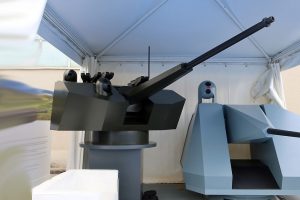
Having a new gun and a new round, the next step was developing new turrets. Two mock-ups, in which the barrel was definitely not that of the X-Gun, were visible at SeaFuture, the HITFIST 30 UL and the Lionfish 30. Common features include compactness and light weight, high accuracy thanks to two stabilised servo systems, an independent line-of-sight using an electro-optical director, autonomous lead angle calculation or their acquisition from an external fire control system, autonomous or slaved designation capability, AI-based decision support algorithms providing automatic threat identification and tracking, and cybersecurity compliance. Both turrets are also fitted with trainer and emulator that allow operational training.
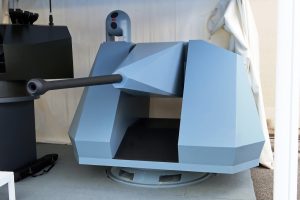
The exhibition being mostly naval let’s start from the Lionfish 30, which according to Leonardo is the last member of the family. Beside the aforementioned C-UAS role, which is becoming increasingly important, the new Leonardo 30 mm mount can be used against helicopters and slow and low flying airplanes as well as against high speed surface vessels. It inherits the Lionfish family architecture and integrates technologies developed for Leonardo bigger-calibre guns. Radar cross section is quite low due to the shape and material used. A non-penetrating turret, it needs only power supply and the link to the control console or the ship fire control system, autonomous control thanks to the built-in video tracker being also possible. The console provided with the system, should this be controlled remotely, features both touch-screen and joystick controls, the latter being essential when operating on small vessels at high speed and rough seas- A back-up battery is installed in the turret, allowing operation even if the ship power fails. Two chutes host 100 linked rounds each, double feed allowing flexibility of use; it is to note that both ammunition belts remain fully inside the turret, and are therefore not exposed to natural elements. Leonardo developed a quick-reload system based on boxes containing two layers of rounds each. Overall the Lionfish 30 weighs less than 1,450 kg without ammunition. First deliveries of the Lionfish 30 are expected in 2026, the turret to be installed on Italian Navy ships of new construction, the first being the PPX, two export clients also waiting for the new turret.
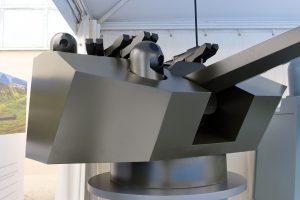
Coming to land, the HITFIST30 UL (Unmanned Light) remotely controlled overhead weapon station (RCOWS) is even lighter than its naval counterpart, its dry weight being less than 1,200 kg. One of the first targets for Leonardo is the fire support version of the new Italian armed forces amphibious vehicle that will enter service with the Joint Navy/Army amphibious capability. While the first batch on order will not see any support vehicle, the next batches should include over 20 of these 8×8 vehicles armed with a medium calibre remotely controlled turret. The number of rounds is an issue as one 30×173 mm round, with its link, weighs around 1 kg, while low profile is also key to survivability, hence the two time 75 rounds proposed by Leonardo; an option for 170 rounds is also available. The turret electronics is mostly derived from that of the HITFIST family, with which the new member maintains over 80% commonality. The turret can be used in Hunter/Killer and Killer/Killer operating modes and can be fitted with antitank missiles or rockets or antiaircraft missiles , the current option being to fit them on the sides, if this does not impact on width limits. The HITFIST 30 UL will also host a coaxial machine gun; according to information acquired by EDR On-Line this should be mounted in a central position and will have a magazine hosting a minimum of 250 rounds. Protection is modular; the weight provided is for the naked turret, the structure providing however a baseline protection that should be close to Level 2. Beside the possible adoption of the HITFIST 30 UL RCOWS on the new Italian 8×8 amphibious vehicles, Leonardo considers its new product as potentially the new turret for future wheeled and tracked vehicles to be developed for the Italian Army, the company obviously looking also at the export market. No dates were provided for the HITFIST 30 availability, but this should be similar to that of the naval turret.
Photos by L. Peruzzi and P. Valpolini


